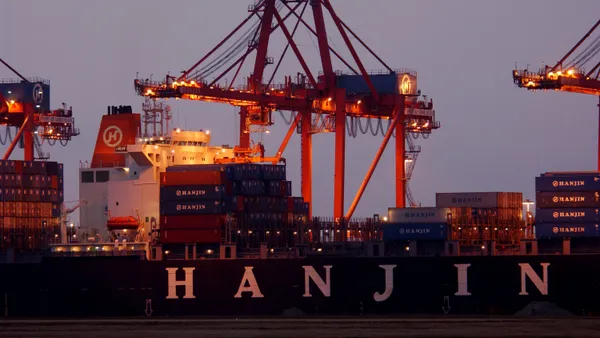Dive Brief:
- The rate of rolled cargo at transshipment ports increased 37% MoM in December, according to the latest figures from Ocean Insights.
- "Of the 20 global ports for which Ocean Insights collates data, 75% saw an increase in the levels of rollover cargo in December compared to the previous month," Ocean Insights' COO Josh Brazil said in a statement.
- Meanwhile, shippers are also dealing with an increased rate of blanked sailings to start 2021. Blanked capacity is expected to reach 13% and 11% of overall capacity in the third and fourth week of January, respectively, according to figures from Sea-Intelligence. Despite this, overall capacity is projected be up 21% YoY and 34% YoY for the same weeks, as carriers have added "larger vessels and extra loaders" to expand their networks.
Dive Insight:
The increased capacity and the uptick in rolled cargo highlight some of the ways in which carriers are attempting to manage the many containers that shippers are trying to move across oceans to meet the demand for consumer goods.
The high cargo volume led to the busiest year on record for The Port of Long Beach, with imports up more than 6% YoY.
As the increase in cargo leads to more rolled cargo, one of the major concerns is refrigerated containers, as some ports in China have reported a short supply of the plugs required to power such equipment, according to Ocean Insights.
CMA CGM and ONE have the highest rate of rolled cargo, with more than half of shipments not being loaded onto the vessel they were scheduled for, according to the figures.
Rolled cargo rate by carrier
| Carrier | November | December |
|---|---|---|
| CMA CGM | 48% | 51% |
| COSCO | 37% | 43% |
| Evergreen | 37% | 44% |
| Hamburg Sud | 30% | 29% |
| Hapag-Lloyd | 42% | 46% |
| Maersk | 32% | 32% |
| MSC | 29% | 29% |
| ONE | 45% | 50% |
SOURCE: Ocean Insights
While blank sailings ticked up through January, the rate is expected to fall in February, well below the rate that was seen in 2020 at the beginning of the pandemic. Figures from eeSea's Blank Sailings Tracker also show a low rate of blank sailings through February and March.
“It’s understandable that cargo owners and their related interests are frustrated by the tight ocean capacity situation these days,"eeSea CEO Simon Sundboell said in a statement. "The impact on their businesses is huge. But there seems to be an impression that carriers are deliberately holding back capacity to push up freight rates. We don’t see that. In fact, effective trade capacity is up."













